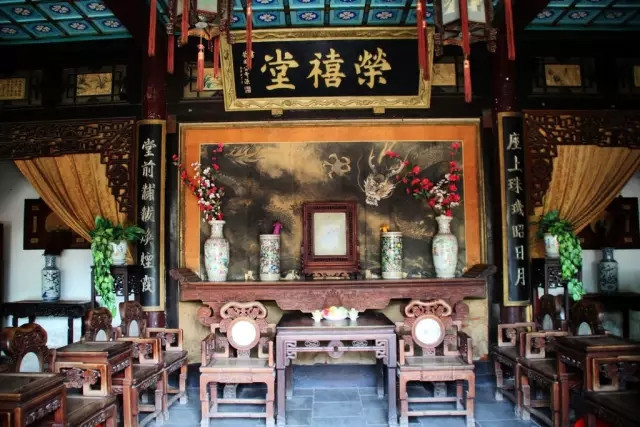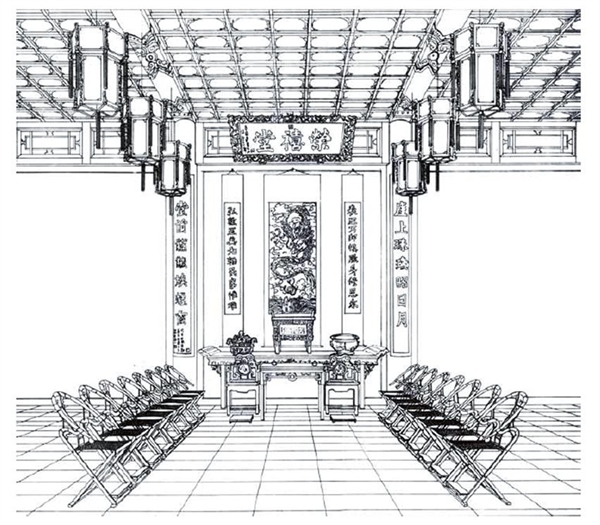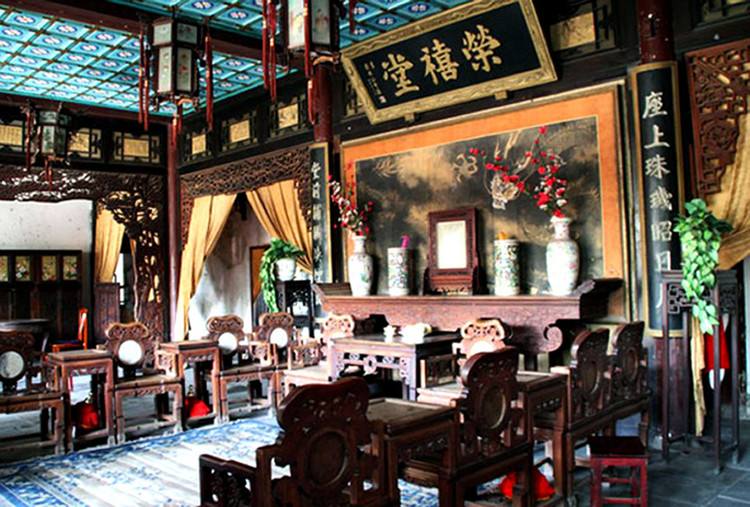《紅樓夢》英譯品讀 (五)
作者:王曉輝
《紅樓夢》不僅是一部偉大的文學作品,也是一部中國明清時代社會生活的百科全書。詩詞歌賦,酒令燈謎,花鳥魚蟲,星象中醫,涵蓋了當時社會生活的方方面面。清代學者王希廉謂其“包羅萬象,囊括無遺,可謂才大如海,豈是別部小說所能望其項背。”
撇開錯綜復雜的故事情節不說,僅書中涉及的樓閣廳堂楹聯匾額器物擺設就夠開一門民俗課了。

《紅樓夢》第三回, 林黛玉到榮國府見王夫人。內堂的陳設是這樣的:
“進入堂屋中,抬頭迎面看見一個赤金九龍青地大匾,匾上寫著斗大的三個大字,是“榮禧堂”,后有一行小字:“某年月日,書賜榮國公賈源”,又有“萬幾宸翰之寶”。大紫檀雕螭案上,設著三尺來高青綠古銅鼎,懸著待漏隨朝墨龍大畫,一邊是金蜼彝,一邊是玻璃??,地下兩溜十六張楠木交椅,又有一副對聯,乃烏木聯牌,鑲著鏨銀的字跡,道是:
“座上珠璣昭日月,堂前黼黻煥煙霞。”
曹雪芹通過對堂屋陳設擺件的描寫,展示了榮國府的奢華與尊貴。這些陳設擺件,極具中國特色,有些甚至是中國獨有的東西。譯者如果要向外國讀者解釋清楚,同時還要保持語言的流暢優美,實在是太不容易了。
原文第一句,霍克斯的譯文是:
High overhead on the wall facing her as she entered the hall was a great blue board framed in gilded dragons, on which was written in large gold characters
THE HALL OF EXALTED FELICITY
with a column of smaller characters at the side giving a date and the words '...written for Our beloved Subject, Jia Yuan, Duke of Rong-guo', followed by the Emperor's private seal, a device containing the words 'kingly cares' and 'royal brush' in archaic seal-script.
楊憲益先生的譯文:
Once inside the hall she looked up and her eye was caught by a great blue tablet with nine gold dragons on it, on which was written in characters large as peck measures:
Hall of Glorious Felicity
Smaller characters at the end recorded the date on which the Emperor had conferred this tablet upon Chia Yuan, the Duke of Jungkuo, and it bore the imperial seal.
譯文流暢準確,這一點毋庸置疑,只是在翻譯的方法上,霍克斯和楊憲益各有側重。楊憲益語言精練,敘述清楚,而霍克斯則更多地站在外國讀者的角度,力求把每一個細節都解釋得明明白白。

“赤金九龍青地大匾”,霍克斯的譯文是‘a great blue board framed in gilded dragons’,一個青色的大匾額,上面描有金龍,環繞在匾額的四周;楊憲益的譯文是‘a great blue tablet with nine gold dragons on it’,一只青色大匾,上面有九條龍。原文中曹雪芹并沒有說明那九條描金的龍究竟在匾上什么位置,但霍克斯根據自己對匾額的理解,清楚地告訴讀者那些描金的龍是在匾額的框子上的(framed in gilded dragons),讓沒有親眼見過匾額的英語讀者腦海中有了清晰的形象。
匾額上“榮禧堂”三字,霍楊二人的翻譯大同小異,Glorious與Exalted意思雖有細微差別,但無關宏旨。值得注意的是“榮禧堂”后面的一行小字:“某年月日,書賜榮國公賈源”,又有“萬幾宸翰之寶”。楊憲益先生言簡意賅,用敘述語言說明后面一行小字記錄了皇帝賜匾的時間并鈐有一枚玉皇帝的印章。霍克斯則不厭其煩,不僅將匾額上小字的內容逐字譯出,還加入了自己的解釋。最有意思的是霍克斯將“書賜榮國公賈源”譯成了‘written for Our beloved Subject, Jia Yuan, Duke of Rong-guo’,再倒譯回中文就成了“寫給我們親愛的的大臣榮國公賈源”。這很明顯是西方君主的題贈習慣,也非常易于英語讀者的理解,但這樣翻譯就成了朋友之間的筆墨往來,把皇帝和大臣放在平等的位置上了。漢語中也有“愛卿”一詞,是皇帝對臣子的愛稱,翻譯過來還就是my beloved subject,但這種稱呼多見于小說特別是戲曲,現實生活中很少見。
對匾額上那枚印章的翻譯,霍克斯也是煞費苦心。中國古代對于印章非常講究,皇帝用“璽”,大臣用“印”,老百姓用的叫“戳兒”,從字面上看尊貴和正式程度上就有天壤之別,普通百姓用印也就是隨便“戳”一下子,留個印記而已。一般皇帝在題字、藏書時用的印章與冊封、頒詔時用的玉璽是不一樣的,屬于“閑章”,如乾隆皇帝的“古稀天子之寶”和“十全老人之寶”,書中提到的這枚“萬幾宸翰之寶”也是一枚閑章。霍克斯沒有用‘imperial seal’,而是翻譯成了‘the Emperor's private seal’,顯然是做足了功課。不僅如此,他還將印章上的“萬幾”和“宸翰”也完整譯出。“萬幾”就是“日理萬機”的“萬機”,表示皇帝很忙,“宸翰”則是“御筆”的意思,所以,霍克斯最后將這枚印章描述為‘... followed by the Emperor's private seal, a device containing the words 'kingly cares' and 'royal brush' in archaic seal-script’,可謂細致入微。不過,加上了‘kingly care’和‘royal brush’也有可能給英語讀者帶來新的困惑。從這些細節也可以看出來,霍、楊兩位大師在翻譯理念上還是有差異的。
原文的第二句主要是描寫廳堂中的器物擺設和一副對聯,霍克斯是這樣翻譯的:
A long, high table of carved red sandalwood, ornamented with dragons, stood against the wall underneath. In the center of this was a huge antique bronze ding, fully a yard high, covered with green patina. On the wall above the ding hung a long vertical scroll with an ink-painting of a dragon emerging from clouds and waves, of the kind often presented to high officials in token of their office. The ding was flanked on one side by a smaller antique bronze vessel with a pattern of gold inlay and on the other by a crystal bowl. At each side of the table stood a row of eight yellow cedar-wood armchairs with their backs to the wall; and above the chairs hung, one on each side, a pair of vertical ebony boards inlaid with a couplet in characters of gold:
(on the right-hand one)
May the jewel of learning shine in the house more effulgently than the sun and moon.
(on the left-hand one)
May the insignia of honor glitter in these halls more brilliantly than the starry sky.
楊憲益先生的譯文相對簡潔,字數只有霍克斯譯文的一半左右。對于紫檀雕螭案、青綠古銅鼎、金蜼彝、玻璃??、楠木交椅等物件的名稱,霍克斯與楊憲益的翻譯非常相近,所不同的是霍克斯按照中國傳統廳堂的設置,還原了每一樣家具和擺設的位置以及相互的空間關系。以“大紫檀雕螭案”為例,霍克斯在‘a table of carved red sandalwood ornamented with dragons’之外,還加上了‘stood against the wall underneath’,告訴讀者“匾額下靠墻立著一個紫檀雕螭大條案”。另外,在翻譯“待漏隨朝墨龍大畫”時,霍克斯沒有簡單地說‘there hung a big picture of ink-painting dragon in the sea (or waves),而是告訴讀者,‘On the wall above the ding hung a long vertical scroll with an ink-painting of a dragon emerging from clouds and waves, of the kind often presented to high officials in token of their office’(在鼎的上方墻上,掛著一幅豎軸大畫,畫中一條墨龍在云海中飛騰,此類題材的畫作,往往是獻給達官貴人的,以彰顯其地位之榮耀)。霍克斯一定是下功夫研究了中國古典廳堂陳設的規矩,知道什么是“條案”,什么是“中堂畫”,所以,他才將“大紫檀雕螭案”翻譯成 ‘a long, high table of carved red sandalwood, ornamented with dragons’,將“待漏隨朝墨龍大畫”翻譯成‘long vertical scroll’。

這段文字的最后是一副對聯:
座上珠璣昭日月,堂前黼黻煥煙霞。
這是一副非常典型的中堂對聯,懸掛在正廳,與中間的“待漏隨朝墨龍大畫”相呼應,彰顯了賈府的榮耀地位。
霍克斯的翻譯:
(on the right-hand one)
May the jewel of learning shine in the house more effulgently than the sun and moon.
(on the left-hand one)
May the insignia of honor glitter in these halls more brilliantly than the starry sky.
楊憲益的翻譯:
Pearls on the dais outshine the sun and moon;
Insignia of honor in the hall blaze like iridescent clouds.
英語是字母文字,不能像漢語一樣,上下聯在結構和長短上一一對應,但可以看出兩位譯者已經盡了最大努力,使上下聯相對整齊。從翻譯效果上看,楊譯簡潔工整,意象鮮明;霍譯深入細致,滴水不漏。
珠璣是指珠寶,黼黻則是官服上的紋飾,這兩句話形容在此居住和往來的人物衣著華貴,光彩照人。霍克斯不僅將對聯的內容準確譯出,還捕捉到了對聯文字背后的隱喻。“珠璣”二字,字面上是指珠寶,但更多的是用來比喻優美的辭章和文字,如“字字珠璣”“滿腹珠璣”“口吐珠璣”,所以,這副對聯說的是賈府詩書傳家,文彩俊逸,而且世代簪纓,富貴尊榮。霍克斯將“座上珠璣”翻譯成‘the jewel of learning in the house’, 意思是座上賓客,文彩風流,談吐不俗,點出了“珠璣”的深一層含義。
讀《紅樓夢》英譯本最大的收獲,就是進一步感受到原著的博大精深,從而更加體會到譯者的艱辛。霍克斯為了專心翻譯《紅樓夢》,毅然辭去牛津大學教授的職位;楊憲益、戴乃迭夫婦,歷經政治沖擊和生活的磨難,仍在古稀之年,筆耕不輟。翻譯大師嘔心瀝血之作,拓展了《紅樓夢》的生命空間,也最完整的詮釋了“譯者”二字的真正內涵。
 0
0 






